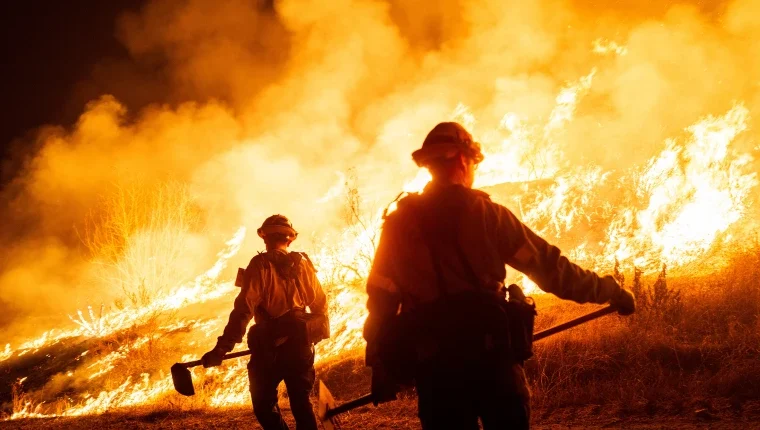A new, fast-moving wildfire has erupted in Los Angeles County, prompting tens of thousands of people to evacuate a region already reeling from the most destructive fires in its history.
The Hughes fire ignited 45 miles (72km) north-west of the city of Los Angeles on Wednesday morning, near Castaic Lake in a mountainous area that borders several residential areas and schools.
It grew to more than 10,000 acres in several hours on Wednesday, fuelled by winds and dry brush. No homes or businesses have been damaged, and officials expressed confidence about getting it under control.
The new fire is north of the two mammoth blazes that have destroyed a number of neighbourhoods this month.
Local news showed residents near the Hughes fire hosing down their homes and gardens with water and others rushing to evacuate.
Orange flames lined the mountains as aircraft dropped water and flame retardant.
The region is once again under a red flag warning, continuing through Thursday. This cautions of a high fire risk due to strong winds and dry, low-humid conditions.
Winds in the area were blowing at about 20-30mph (32-48km/h), but could pick up, which would fan the blaze and make it harder for air crews to operate.
Climate change has made the grasses and shrubs that are fuelling the Los Angeles fires more vulnerable to burning, scientists have said.
Rapid “whiplash”-style swings between dry and wet conditions in the region in recent years have created a massive amount of tinder-dry vegetation that is ready to catch fire.
About 31,000 people in the area are under a mandatory evacuation order and another 23,000 have been warned they may have to flee, Los Angeles County Sheriff Robert Luna said. Nearly 500 inmates at a local jail were being evacuated, he added.
The fire continued to grow as the sun set on Wednesday, but Los Angeles County fire chief Anthony Marrone said he believed crews were making progress.
“The situation remains dynamic and the fire remains a difficult fire to contain, although we are getting the upper hand,” he said. The fire was declared 14% contained early on Thursday, according to the website of Cal Fire, California’s statewide fire agency.
A fire being 100% contained does not mean it has been extinguished, but rather that the flames have been fully encircled and the spread has been effectively stopped.
Officials said the blaze was different from the Palisades and Eaton fires, which killed at least 28 people and decimated more than 10,000 homes and businesses earlier this month.
Chief Marrone said they were benefiting from lower winds – unlike the 70-90mph winds seen during the previous fires – and having so many helicopters and planes able to fight the blaze from above.
“I think that we’ve all been on edge over the last 16 days,” he said. “We were able to amass a lot of fire resources early on to change what this fire looks like.”
Ed Fletcher, who works for Cal Fire, told the BBC the area was not highly populated and current winds were blowing the fire toward Castaic Lake, which was acting as a buffer for the Castaic area – home to about 20,000 residents.
But “if it jumps the lake, it becomes a much more dynamic situation”, he said.
One woman who fled her home told NBC 4 that she was stuck on Interstate 5, California’s primary transportation highway that runs through the state. Parts of the interstate in the area had been closed because of the fire.
“It looked like a cloud, but as you got close, it looked like we were driving into hell,” she said of the dark smoke and red flames she saw. “It was pretty terrifying.”
She acknowledged being on edge after watching the Palisades and Eaton fires burn nearby. “I don’t know why they keep popping up,” she said. “It’s definitely a scary time in this area.”
Two other fires ignited Wednesday further south, near San Diego and Oceanside. The Lilac fire was declared fully contained after burning 85 acres. Like the separate Center fire, which has covered four acres, it burned in populated areas. Evacuation orders have now been mostly lifted.
Dana Dierkes, a spokesperson for the Angeles National Forest, noted the winds and dry brush had made these recent fires much harder to fight.
“We don’t have a fire season in California. We have a fire year,” she said. “We’ve had wildfires in January before, but it’s exacerbated by the Santa Ana winds. The wind is a huge factor when we’ve had such a dry year.”
Rain is in the weekend forecast in the region, a welcome bit of news to douse the fire threat. But the anticipated rainfall is bringing new fears in the form of mudslides, flooding and landslides.
Areas touched by the recent fires are particularly at risk, because torched grounds are less absorbent.
State Governor Gavin Newsom signed an executive order on Monday to help free up resources for flood and landslide preparation after the fires.
Source:bbc.com





